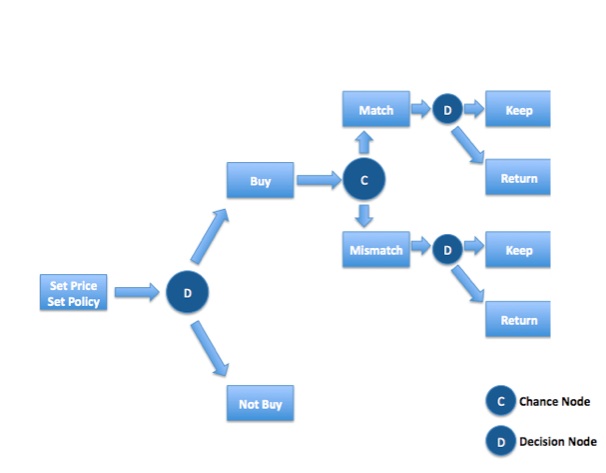Thinking E-Commerce? Think return policies [part 3]

After establishing why return policies are important and what to consider when offering them the last part of this series presents my findings of how to structure an optimal return policy.
Under the influence of risk
In our purchasing decision we factor in all four possible states. There is a probability that the purchased item will not match our expectations where we can either keep the product or, in case a return policy is offered, return it. If the item is a match we also have the same two options. Each option yields a different value for us as customers.

We know that buying things over the internet is especially risky. We also know that for most people risk has a stronger influence on the purchasing decision than value. Additionally, risk has a stronger influence the more risk-averse a customer is. Customers buy if their expected value from the purchase is positive, if it is higher than the risk. The value of the purchase is gained if the product matches our preference, such as when e.g. a shirt fits us well. However, it is also possible that the shirt will not fit us as well as we have imagined when buying it. This possibility makes the risk of the purchase.
In quantitative terms I have included a function that describes the customer’s purchase decision where a customer’s attitude to risk is random. Most customers will be risk averse but some will be risk neutral. This is done by creating a function with a negative second derivative that is 2.5 times steeper for losses than for gains.

In general offering a return policy is more valuable for customers for higher priced products (e.g. refrigerator), products with low probability of good fit (e.g. presents) and products that customers cannot easily salvage themselves (e.g. collectibles).
For the seller offering a return policy makes him subject to the costs, which are the salvage value plus the return charges minus the wholesale price and return costs.
When thinking about offering a return policy the retailer has to consider its own costs (wholesales costs, salvage value, return costs), the customers he targets (risk aversion, probability of fit, return costs), and the product it markets (e.g. price, how fast value can be derived from it).
The optimal return policy
After optimization for a single retailer using genetic algorithms, in summary I can make the following statements:
- There is no overall optimal return policy. Whether or not to offer a return policy or not and the design of the optimal return policy are product-, customer population- and retailer-specific.
- Offering a return policy is preferred if:
- The consumers are heterogeneous with respect to both value of the product and probability of good fit and the returns are not too costly for the retailer
- Consumers are homogeneous with respect to value of the product but heterogeneous with respect to probability of good fit
- Consumers are not able to extract more than half of the product value during trial
- The retailer can profitably salvage the product
- Customers have a low probability of good fit
- Variance of probability of good fit is medium or high
- Selling without offering a return policy is better if:
- The customer can resell the product easily for a high value
- The product returns are costly for the retailer
- If the probability of good fit is high and its variance is small, it makes nearly no difference as to sell with or without RP.
As it would be too complicated to offer different return policies for different product types, as would be optimal, when choosing a return policy, it should be consistent with the retailer’s brand. It might also be effective to offer a very restricted return policy for items with high trial value such as DVDs because of the high cost of customer opportunism. Also offering a return policy for items that are purchased frequently (e.g. groceries) is not necessary and is frequently not done. As offering return policies increases prices, finding product categories that do not require them allows for price reductions in these categories.
Moreover, my model shows that increasing the likelihood that the customer is happy with the purchase boost profits. Therefore, improving the information flow to the customer using videos or reviews is very important.
In a competitive situation, a retailer who has more efficient reverse logistics operations (e.g. who can salvage product returns better) has a competitive advantage as he can offer either a better return policy or the same return policy as the competition while charging lower prices.
Photo by Ibrahim Rifath on Unsplash